Between extremely inefficient processing of repatriation or refugees and asylum seekers, and porous insecure borders, South Africa’s refugee crises and the number of illegal immigrants have both grown.
The United Nations High Commissioner for Refugees (UNHCR) had to step in on an emergency basis at the Paint City site in Belville, Cape Town, last year after the Department of Public Works and Infrastructure (DPWI) had withdrawn sanitation facilities. Now the UNHCR contract for sanitation has also come to an end although the organisation reportedly is assisting with the crisis. The UNHCR is now assisting Home Affairs with the backlog of refugee appeals, which has grown drastically due to inefficiency and failure to appoint resources to the task.
The UNHCR has reported that many refugees in South Africa have an interest to return to their home countries. Others have approached the UNHCR for assistance. In order to protect children, who are most at risk, on 2nd February European Union (EU), the United Nations Children’s Fund (UNICEF) and UNHCR announced the launch of the new EU Global Promotion of Best Practices for Children in Migration programme. South Africa is one of the four countries to benefit from it.
DA Shadow Deputy Minister of Home Affairs, Adrian Roos MP, made the following statement:
“Home Affairs Minister, Dr Aaron Motsoaledi, must put down his popcorn, get off his couch and provide leadership to secure our borders and take charge of issues of refugees and asylum seekers.
The Minister has been standing back and doing as little as possible, while stakeholders such as the City of Cape Town, UNHCR and others have been forced to scramble to fill in the leadership void.
We now face a humanitarian crisis at refugee centres in Cape Town where Home Affairs are conducting drawn-out processes to repatriate or reintegrate refugee groupings. This weekend at the Paint City site in Belville, sanitation and ablution facilities were removed by the UNHCR, who had stepped in on a temporary emergency basis after the Department of Public Works and Infrastructure (DPWI) previous unilateral withdrawal of sanitation. Now the UNHCR contract for sanitation has also come to an end at the DPWI shelter being provided to refugees at Paint City. A DPWI spokesperson has referred the latest withdrawal of sanitation to Home Affairs when questioned.
This is not the first time a humanitarian crisis has developed as a result of Home Affairs’ failure to deliver on their mandate of managing refugees under the Refugee Act.
Two months after the Border Management Authority (BMA) came into effect there is still no project plan with funding and deadlines despite this function being in place for the full term of the Minister to date. The lack of action from Home Affairs to put forward a plan for the expected December/January traffic led to a humanitarian crisis at the borders where NATJOINTS had to step into the leadership void to resolve the crisis with the BMA a passive spectator.
It required the Democratic Alliance (DA) to call out corruption on the Beitbridge Border Project where the Minister claimed that he was not involved and never expressed a concern on infrastructure directly related to his responsibility. The UNHCR has also now filled the void to deal with refugee appeals that Home Affairs has let build-up by not adequately resourcing it.
A pattern is developing of Minister Motsoaledi doing little and other stakeholders coming to the rescue. The only conclusion is that the Minister is not interested in securing our borders and dealing with issues of genuine refugees and asylum seekers and for some purpose wants the problems to continue. This has to stop.
The mandate of Home Affairs is crystal clear. In December 2014 Cabinet directed that Home Affairs should assume responsibility for coordinating all border law enforcement entities in South Africa. The mandate to implement the BMA is under Home Affairs. The 1951 Refugee Convention places a responsibility on National Government to protect legitimate refugees and asylum seekers. The Refugees Act is under Home Affairs as the responsible National Government Department.
Furthermore, the ‘National Action Plan to combat xenophobia, racism, and discrimination’ passed by Cabinet in March 2019 states that “to effectively combat xenophobia, the government and police need to publicly acknowledge attacks on foreign nationals and their property as xenophobic and take decisive action.” The lack of action on the initial claims of xenophobic violence, which came directly after this National Action plan was passed, has morphed into a humanitarian crisis.
The DA long ago called for a stop to finger pointing and called for a Joint Parliamentary Committee meeting on the matter which in October 2019 called on Minister Motsoaledi to facilitate an Intergovernmental engagement on roles, responsibilities and funding when dealing with claims of xenophobia and violence against foireign nationals. To date, the Home Affairs Minister has done little to nothing.
If Home Affairs and National Government want to place their responsibility on to Provinces or City governments then they must do so formally and allocate the necessary budget. The City of Cape Town has paid over R5 million to date at the Wingfield site in Goodwood, Cape Town. The City has called on Home Affairs to urgently conclude repatriation and reintegration processes without delay at both this site and at Paint City.
The DA has written to the Portfolio Committee on Home Affairs to urgently intervene in the humanitarian crisis at Paint City and Wingfield by directing the Minister to implement the recommendation of October 2019 and convene an urgent Intergovernmental engagement to define roles and budget.
The DA will continue to fight to protect our borders and an immigration system that swiftly deals with undocumented immigrants while protecting legitimate asylum seekers who are fleeing genuine oppression.”

